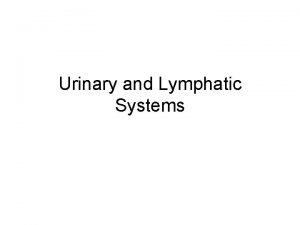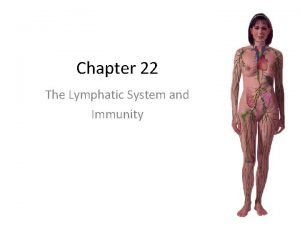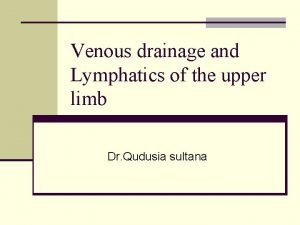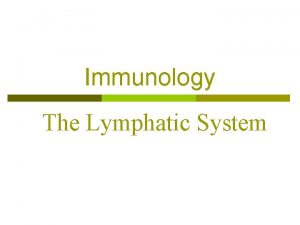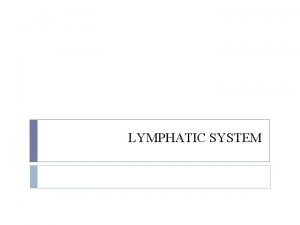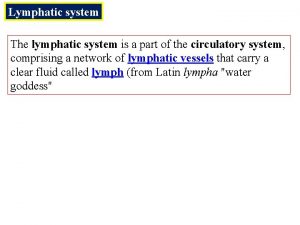Lymphatic system n The lymphatic system is concerned











- Slides: 11


Lymphatic system n The lymphatic system is concerned with return of a fluid called "lymph" back to the blood stream. ·The lymph is clear colourless fluid which is formed at the tissue spaces. It is collected by lymph capillaries from the intercellular spaces. Ø The lymph is composed of : • Plasma of the blood which is not taken up by the venous capillaries. • Proteins from the tissues. • Lymphocytes.

The lymphatic system is composed of: Lymphatic tissues. n Lymphatic vessels. n

Lymphatic vessels (lymphatics): n They start as lymph capillaries, which are small vessels that form networks and start blindly in the intercellular spaces of most tissues. q They are larger in size than blood capillaries. They allow diffusion to substances of large molecular size, which can not pass through blood capillaries e. g. micro-organisms. q They possess numerous valves that give it a beaded appearance, which allow the lymph to pass only in one direction. q They are present in many tissues of the body, but are absent from: Ø Central nervous system (brain and spinal cord). Ø Splenic pulp and bone marrow. Ø Avascular structures (epidermis, cornea and articular cartilage).

Lymphatic Circulation

n The lymph capillaries join to form larger and larger vessels that pass through one or more lymph nodes. At the end, all lymph of the body is collected into two ducts: n Thoracic Duct: n It is the largest lymphatic vessel in the body, which starts at upper end of the cisterna chyli (a dilated lymph sac at level of 2 nd lumbar vertebra), ascends and inclines to the left, and ends by opening into the left innominate vein. n It drains lymph from all body parts except those drained by the right lymphatic duct. n Right lymphatic duct: n It receives lymph from right side of head & neck, right upper limb, and right side of thorax. n It ends by opening into the right innominate vein.

Lymphatic tissues Diffused Encapsulated Tonsils Lymph node Payer’s patches Spleen Vermiform appendix Thymus

Lymph node n n n These are localized bean-like bodies that lie along the course of lymph vessels. They are palpable only if swollen (inflamed). They are present singly or in groups in specific locations in the body. Each node receives many afferent lymphatics that enter the convex side of the node and gives few efferent lymphatics that leave it at concave side.

Spleen n It lies in the left hypochondrium, parallel to 9 th, 10 th, and 11 th ribs. n It has: n 2 ends: n n n 2 borders: n n n Anterior (lateral): reaches the midaxillary line. Posterior (medial): reaches inches from median plane. Superior (notched): which anteriorly has got one or two notches Inferior. 2 surfaces: n n Diaphragmatic: convex and smooth, related to diaphragm and 9, 10 and 11 ribs. Visceral: shows a hilum at its middle where splenic vessels enter and leave. Related to stomach, left kidney, pancreas and colon.

Thymus n n n It lies in the anterior mediastinum. It consists of 2 lobes, connected together by connective tissues. It varies in size and development with the age of the individual: n n After birth, it continues to grow and attains its maximum development around puberty. After puberty, it undergoes involution where it is replaced by connective tissue.

THANK YOU
 Lympathic
Lympathic Lymphatic system
Lymphatic system Lesser saphenous vein
Lesser saphenous vein What are the function of lymphatic system
What are the function of lymphatic system Chapter 12 the lymphatic system and body defenses
Chapter 12 the lymphatic system and body defenses Functions of the lymphatic system
Functions of the lymphatic system Totally tubular dude
Totally tubular dude Lymphatic system organs and functions
Lymphatic system organs and functions Lymphatic system
Lymphatic system Lymph composed of
Lymph composed of Chapter 10 lymphatic system diseases and disorders
Chapter 10 lymphatic system diseases and disorders Scapula lymph nodes
Scapula lymph nodes



